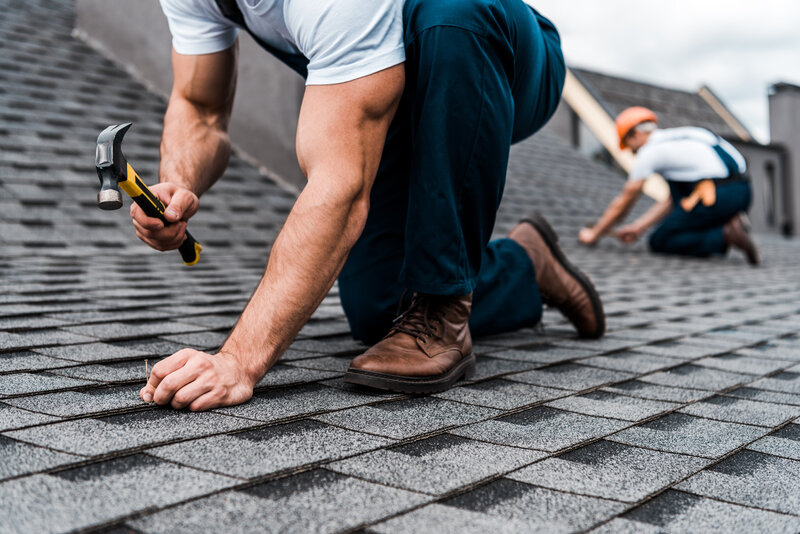-

Do you suspect your roof was poorly installed? The good news is, signs of a poorly installed roof are typically visible from the curbside. Unfortunately, the roof needs to be repaired or replaced.
A shoddy roof job should never be overlooked. In addition to diminishing the home’s curb appeal, a poor roof job makes the rest of your home more susceptible to damage, leaks, mold/mildew, fluctuating temperatures, and higher utility bills.
9 Signs You Have A Poorly Installed Roof
If you notice any of the following, we recommend contacting the original roof contractor to check-in. If you feel uncomfortable with that option, contact your homeowner’s insurance and they’ll provide instructions on how to move forward.
The shingles are crooked or misaligned
A crooked shingle here or there may be a sign the roof is old and shingles are inevitably coming loose, blowing off, or falling apart. However, if the crooked shingles are still attached – it’s a poor shingle job. And, if rows of shingles are crooked, wavy, or misaligned, improper installation is a given.
Beyond looking sloppy, misaligned shingles aren’t providing the water protection and runoff they’re designed to. If that’s the only problem, the roof needs to be reshingled. However, any company that installs crooked shingles probably slacked off in other areas of the roof installation.
Shingles blew off or are damaged after a storm
If your roof is less than 15 years old, and shingles are blowing off in storms, it may be that the installer used incorrect nail length or improper nail placement. Schedule a roof inspection with a licensed roofer to see what’s going on.
The new roof was installed over the old roof
California building codes allow for two layers of shingles, which means you can technically install new roofing materials over an original layer. However, this is a terrible practice and puts your room – and the home’s structural integrity – at risk. If you need an entirely new layer of shingles, as opposed to a minor repair or a few shingle replacements, odds are you need a new roof – roof deck, underlayments, and all.
The roofline is sagging
Most of the time, a sagging roofline means you’re overdue for a new roof. However, a poorly installed roof may begin to sag sooner than it should. When you view your roof from the ground, it should look completely straight without any sagging or disproportionate sloping.
Reused flashing
If you pay for a new roof, the materials should be new. We’re all for repurposing and reusing materials when you can, but flashing is not one of those. Used flashing should be reused on another structure or put into metal recycling. If your roofer is reusing materials to cut costs, they’re not performing high-quality work and are also violating the building code.
Your poorly installed roof is leaking
A new roof should be leak-proof. If your roof leaks during storms in the first several years, contact the roofer ASAP to repair the issue. Look for evidence of leaks in common areas, like the areas where the roof meets the exterior walls and around roof penetrations (chimneys, vents, etc.).
A poorly ventilated attic
The roof and attic system work together to provide whole-home comfort and moisture control. Without adequate ventilation, including the installation of ridge vents and soffits, moisture accumulation in the attic leads to rusted flashing and a roof that ages faster than it should.
Missing roof parts
A high-quality roof is only as good as the sum of its parts. If parts are missing, the roof won’t function like it should. We recommend homeowners gain a basic understanding of roofing anatomy. Even a cursory awareness is enough to recognize if the roof is missing key components like:
- A drip edge
- Ridge cap
- Gutter and downspouts
- Flashing and seals around roof penetrations
Roof stains
If the roof is old, poorly installed, or not maintained it is prone to algae or moss growth. This is fairly common here in the Bay Area, where the combination of moisture and sunshine provides the ideal environment for algae and moss spores to establish themselves. While the look may be charming, it indicates a slow decay and decline of your roof.
If you see stains or growth of any type, contact a roofer and schedule a roof inspection. First, you need to determine why your roof is playing host in case repairs, or replacements, are needed. If the roof is solid, then the next step is to safely clean the roof to prevent further damage.
Contact Central Bay Roofing If You Suspect Your Roof Is Poorly Installed
Do you have a feeling your roof was installed incorrectly or that the contractor didn’t do a top-quality job? Schedule a roof inspection with Central Bay Roofing. We’ll let you know if we see any installation-related issues and how you should proceed. In most cases, a simple call to the original roofer generates a repair call that is covered under your warranty.
Does Your Home Have A Poorly Installed Roof?
Call Us On (510) 521-7334
Your Local Roofers Since 1978
We invite you to contact us today for an estimate on your roofing project.
1814 Clement Avenue Alameda, CA 94501
(510) 521-7334
info@centralbayroofing.comLicense: 435272 Class B, C-39
Site powered by RooferBoost
Copyright 2017 Central Bay Roofing and Restoration | Login
